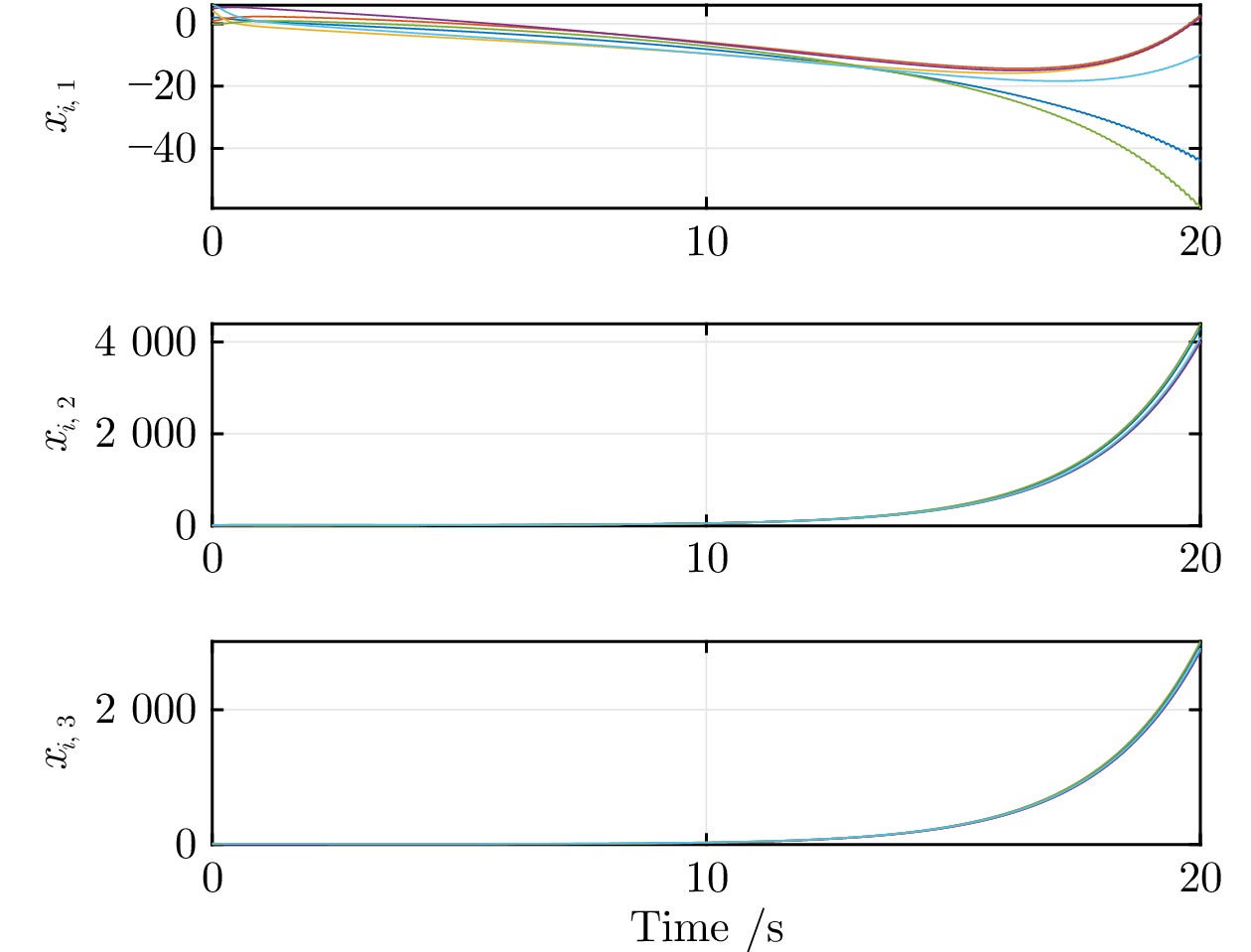|
[1]
|
Yu C B, Hendrickx J M, Fidan B, Anderson B DO, Blondel V D. Three and higher dimensional autonomous formations: Rigidity, persistence and structural persistence. Automatica, 2007, 43(3): 387–402 doi: 10.1016/j.automatica.2006.08.025
|
|
[2]
|
Su H S, Wang X F, Lin Z L. Flocking of multi-agents with a virtual leader. IEEE Transactions on Automatic Control, 2009, 54(2): 293–307 doi: 10.1109/TAC.2008.2010897
|
|
[3]
|
Cortés J. Distributed algorithms for reaching consensus on general functions. Automatica, 2008, 44(3): 726–737 doi: 10.1016/j.automatica.2007.07.022
|
|
[4]
|
Ren H R, Wang Y, Liu M, Li H Y. An optimal estimation framework of multi-agent systems with random transport protocol. IEEE Transactions on Signal Processing, 2022, 70: 2548–2559 doi: 10.1109/TSP.2022.3175020
|
|
[5]
|
Hu Z P, Ren H R, Shi P. Synchronization of complex dynamical networks subject to noisy sampling interval and packet loss. IEEE Transactions on Neural Networks and Learning Systems, 2022, 33(8): 3216–3226 doi: 10.1109/TNNLS.2021.3051052
|
|
[6]
|
Olfati-Saber R, Fax J A, Murray R M. Consensus and cooperation in networked multi-agent systems. Proceedings of the IEEE, 2007, 95(1): 215–233 doi: 10.1109/JPROC.2006.887293
|
|
[7]
|
Yu W W, Chen G R, Cao M. Some necessary and suffcient conditions for second-order consensus in multi-agent dynamical systems. Automatica, 2010, 46(6): 1089–1095 doi: 10.1016/j.automatica.2010.03.006
|
|
[8]
|
Li Z K, Ren W, Liu X D, Fu M Y. Consensus of multi-agent systems with general linear and Lipschitz nonlinear dynamics using distributed adaptive protocols. IEEE Transactions on Automatic Control, 2012, 58(7): 1786–1791
|
|
[9]
|
Li Z K, Wen G H, Duan Z S, Ren W. Designing fully distributed consensus protocols for linear multi-agent systems with directed graphs. IEEE Transactions on Automatic Control, 2015, 60(4): 1152–1157 doi: 10.1109/TAC.2014.2350391
|
|
[10]
|
Han T, Guan Z H, Xiao B, Wu J, Chen X. Distributed output consensus of heterogeneous multi-agent systems via an output regulation approach. Neurocomputing, 2019, 360: 131–137 doi: 10.1016/j.neucom.2019.06.028
|
|
[11]
|
Wieland P, Sepulchre R, Allgöwer F. An internal model principle is necessary and suffcient for linear output synchronization. Automatica, 2011, 47(5): 1068–1074 doi: 10.1016/j.automatica.2011.01.081
|
|
[12]
|
Trentelman H L, Takaba K, Monshizadeh N. Robust synchronization of uncertain linear multi-agent systems. IEEE Transactions on Automatic Control, 2013, 58(6): 1511–1523 doi: 10.1109/TAC.2013.2239011
|
|
[13]
|
Xu X, Liu L, Feng G. Consensus of discrete-time linear multiagent systems with communication, input and output delays. IEEE Transactions on Automatic Control, 2018, 63(2): 492–497 doi: 10.1109/TAC.2017.2720703
|
|
[14]
|
Li X W, Soh Y C, Xie L H. Robust consensus of uncertain linear multi-agent systems via dynamic output feedback. Automatica, 2018, 98: 114–123 doi: 10.1016/j.automatica.2018.09.020
|
|
[15]
|
Li Z K, Duan Z S, Chen G R, Huang L. Consensus of multiagent systems and synchronization of complex networks: A unified viewpoint. IEEE Transactions on Circuits and Systems I: Regular Papers, 2010, 57(1): 213–224 doi: 10.1109/TCSI.2009.2023937
|
|
[16]
|
Zhou B, Xu C C, Duan G R. Distributed and truncated reducedorder observer based output feedback consensus of multi-agent systems. IEEE Transactions on Automatic Control, 2014, 59(8): 2264–2270 doi: 10.1109/TAC.2014.2301573
|
|
[17]
|
Lu M B, Liu L. Cooperative output regulation of linear multiagent systems by a novel distributed dynamic compensator. IEEE Transactions on Automatic Control, 2017, 62(12): 6481–6488 doi: 10.1109/TAC.2017.2658026
|
|
[18]
|
Lv Y Z, Wen G H, Huang T W, Duan Z S. Adaptive attackfree protocol for consensus tracking with pure relative output information. Automatica, 2020, 117. Article No.108998 doi: 10.1016/j.automatica.2020.108998
|
|
[19]
|
Li X W, Soh Y C, Xie L H. A novel reduced-order protocol for consensus control of linear multi-agent systems. IEEE Transactions on Automatic Control, 2019, 64(7): 3005–3012 doi: 10.1109/TAC.2018.2876390
|
|
[20]
|
Seo J H, Shim H, Back J. Consensus of high-order linear systems using dynamic output feedback compensator: Low gain approach. Automatica, 2009, 45(11): 2659–2664 doi: 10.1016/j.automatica.2009.07.022
|
|
[21]
|
Li X W, Soh Y C, Xie L H. Output-feedback protocols without controller interaction for consensus of homogeneous multi-agent systems: A unified robust control view. Automatica, 2017, 81: 37–45 doi: 10.1016/j.automatica.2017.03.001
|
|
[22]
|
Zhao Y, Wen G H, Duan Z S, Xu X, Chen G R. A new observer-type consensus protocol for linear multi-agent dynamical systems. Asian Journal of Control, 2013, 15(2): 571–582 doi: 10.1002/asjc.572
|
|
[23]
|
Lv Y Z, Wen G H, Huang T W. Adaptive protocol design for distributed tracking with relative output information: A distributed fixed-time observer approach. IEEE Transactions on Control of Network Systems, 2020, 7(1): 118–128 doi: 10.1109/TCNS.2019.2919855
|
|
[24]
|
Stoorvogel A A, Saberi A, Zhang M R. Solvability conditions and design for state synchronization of multi-agent systems. Automatica, 2017, 84: 43–47 doi: 10.1016/j.automatica.2017.06.016
|
|
[25]
|
Scardovi L, Sepulchre R. Synchronization in networks of identical linear systems. Automatica, 2009, 45(11): 2557–2562 doi: 10.1016/j.automatica.2009.07.006
|
|
[26]
|
Xu J, Xie L H, Li T, Lum K Y. Consensus of multi-agent systems with general linear dynamics via dynamic output feedback control. IET Control Theory & Applications, 2013, 7(1): 108–115
|
|
[27]
|
李润梅, 张立威, 王剑. 基于时变间距和相对角度的无人车跟随控制 方法研究. 自动化学报, 2018, 44(11): 2031-2040Li Run-Mei, Zhang Li-Wei, Wang Jian. A control method of unmanned car following under time-varying relative distance and angle. Acta Automatica Sinica, 2018, 44(11): 2031–2040.
|
|
[28]
|
Hou M, Muller P C. Design of observers for linear systems with unknown inputs. IEEE Transactions on Automatic Control, 1992, 37(6): 871–875 doi: 10.1109/9.256351
|
|
[29]
|
Ren W, Beard R W. Consensus seeking in multi-agent systems under dynamically changing interaction topologies. IEEE Transactions on Automatic Control, 2005, 50(5): 655–661 doi: 10.1109/TAC.2005.846556
|





 下载:
下载:



